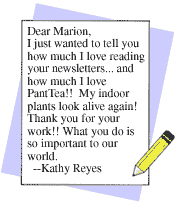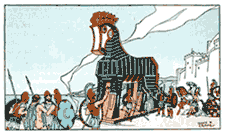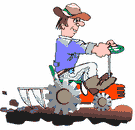
Roto-tilling is a No-no!
And how Jethro Tull led us astray
By Marion Owen, Fearless Weeder
for PlanTea, Inc. and
Co-author of Chicken Soup for the Gardener's Soul
FEATURE ARTICLE:

Tom Hanks' "Power of Four" solution
More good stuff:
Who is Marion Owen?
FAQs about PlanTea
Search Marion's articles, tips and recipes
Why grow organic?
News and press releases
Read love letters
How to link to this site
Need a speaker?
How to contact Marion
Visiting Alaska?
Come to Kodiak Island!
Go to home page

Marion's UpBeet Gardener
Newsletter has been
replaced by Marion's blog
which you can find at:
www.marionowen.wordpress.com
 Many
years ago in a village far, far away, several young soldiers spent the
evening at the village pub. On their way home they spotted a giant wooden
horse outside their walled compound. It was so big, they couldn't see
the top of the horse's back. It must be a gift, they thought. With that,
they pushed it across the bridge and through the gates.
Many
years ago in a village far, far away, several young soldiers spent the
evening at the village pub. On their way home they spotted a giant wooden
horse outside their walled compound. It was so big, they couldn't see
the top of the horse's back. It must be a gift, they thought. With that,
they pushed it across the bridge and through the gates.
During the night, a small door on the side of the wooden horse opened.
One by one, enemy soldiers climbed out of the horse's hollow belly.

You know the rest of the Trojan Horse story. The lesson
is that you can't always take things at face value. The following, real-life
Trojan horse story doesn't have a gruesome ending, but it taught me a
valuable lesson -- and one you CAN take at face value.
Last August I received an email from a company rep that
sells garden products. A couple days later, the phone rang. "You're a
garden writer who lives in Alaska, right?" the lady with the 20-something
voice asked.
"Well, yes, I am? What can I do for you?" I replied after a long pause
caused by the satellite phone link.
"We'd like you test our tiller. If we send one to you, would you try it
out and send us your thoughts on how it worked for you?"
"Sure thing," I said absentmindedly, thinking that if someone wanted to
send me a piece of equipment all the way to Alaska they must really want
my opinion.
The Trojan Horse tiller arrives
Weeks passed. One day, I returned home after running errands
to find a large, heavy-duty cardboard box blocking the front door.
 "What the heck is this?" My memory kicked in as I scanned the words "Wizard
Tiller" on the side of the box.
"What the heck is this?" My memory kicked in as I scanned the words "Wizard
Tiller" on the side of the box.
The promised tiller had landed. Ugh. I liked using a roto-tiller in my
garden about as much as I liked dropping a refrigerator on my foot.
It's not that I have anything against the machines. And surely it has
nothing to do with the display ads in gardening and home improvement magazines
showing a model -- usually a young lady --smiling while operating a tiller
with one hand. Like you, I believed the ads and figured roto-tiller, like
drill bits, solved problems. They made short work of turning the soil
and preparing a garden for planting, right?
Thankfully, science and common sense is showing us The Way. (Keep reading,
and you'll learn how Jethro Tull fits in all this.)
Why is deep tilling a bad thing?
Before I answer that, deep tilling doesn't apply to hoeing a row or using a pitchfork to turn over the first few inches of soil. Nor does it apply to tilling in, say, prairie sod to establish a new garden. Deep tilling means repeatedly cutting up soil with a roto-tiller.

What can I say? Healthy worms
are happy worms!
"Managing your soils to keep this living system thriving can make the difference between gardening success and failure," says Rodale's Encyclopedia of Organic Gardening -- An excellent reference. You can buy inexpensive, used copies through Amazon.com.

What makes good soil? Texture and structure are as important as the foundation
of your home. You need it to enjoy and maintain a healthy lifestyle.
Soil is more than dirt!
Soil is more than dirt. In fact, it's 50 percent minerals and 50 percent
water and air. Let that sink in for a moment. Half of soil is minerals,
and the rest is water and air. The spaces between the minerals (made of
tiny rock fragments) are the holding areas for soil water and air, the
super highways by which nutrients travel and connect everything in the
soil.
Ideal soil is friable, which means the various particles form little clusters
with air pockets between them. Having said that, try this simple soil
test, which happens to be the same sort of test that early pioneers used
to sample the land as they moved west across the United States in search
of good land.
Here's what you do: Squeeze a handful of your garden soil. Now loosen
your grip and study what's in your hand. Does it stick to your fingers
like clay, all wet and soggy-like? Or does it spring back a little, have
some give and fluff to it? Now take a sniff. How does it smell? Sour,
like old cheese, or earthy and sweet?

Follow your nose!
Fluffy and earthy smelling is what you want. To get there,
you can choose from numerous gardening practices that support healthy
soil. For example:
+ Raised beds
+ Topping with mulch
+ Turning compost
in the top 4 to 6 inches
On the flip side, here are some things that actually harm soil structure:
+ Walking on the soil
+ Using chemical fertilizers (they
kill friendly organisms and acidify the soil over time)
+ Deep tilling or roto-tilling
I turned to my garden-writer friend Jeff Lowenfels, who lives in Anchorage,
Alaska. Jeff, a recent anti-tiller convert, writes a column for the Anchorage
Daily News, which happens to be the longest-running garden column
in the United States.
"Jeff, I have a roto-tiller sitting on my front porch. Lots of folks roto-till
their gardens. What's so bad about it?" I asked.

This man should NOT be smiling.
Studies show that deep tilling damages soil.
"Roto-tilling destroys the network of fungal hyphae that
gives soil structure," he explained." This includes the mychorrhizal network
that is so important to plants."
Mycorrhizal (MY-coh-RIZE-ul) fungi are multi-celled organisms that form
special "I'll scratch your back if you'll scratch mine" relationships
with plant roots. As recent electron microscope images have shown, these
organisms develop into long chains called hyphae (HIGH-fee) and get energy
from the plant and help supply nutrients to the plant. In other words,
they depend on each other for survival.
Roto-tilling, says Lowenfels, dislocates and chops up small invertebrate
animals (such as insects, worms and spiders), and bacteria, and it kills
worms and destroys aeration and drainage. "The soil looks nice and smooth,
but it quickly looses structure, especially in places like Kodiak
Island, Alaska where you get lots of rain."

According to Lowenfels, whose company Alaska
Humus is all about healthy soil, rototilling is an addiction, like
lawns and coffee. "We till because early American's fell under the spell
of an English country lawyer, Jethro Tull, who thought that roots eat
soil particles and the smaller you pulverize soil, the easier it is for
roots to eat it."
This was back in the days of Thomas Jefferson. "No one knew about the
need for fungi to provide soil structure or about the soil foodweb and
how rototilling completely disrupts it. We've come a long way!"
For more information about the soil foodweb, a term coined by Dr. Elaine
Ingham, visit her informative www.soilfoodweb.com
web site. Her business mission statement sums it all up: "To grow healthy,
productive plants you need healthy, productive soil. It is the organisms
in the soil that provide the food plants need, in the form they need,
when they need it."
What about breaking up sod?
When it comes to gardening efforts, Lowenfels advocates that less is more. He says there is one time when using a tiller is okay: when breaking up sod-grass. "Just do one pass to break up the sod. One pass only." Jeff then adds "The less energy you can use when planting, the better," he says. "Control weeds with mulches, in the case of annuals and vegetables, green mulches and in the case of perennials, shrubs and trees, brown mulches."
|
"All plants--grass, trees, shrubs, agricultural crops--depend on the food web for their nutrition."----Soil and Water Conservation Society |
The idea is to avoid compacting and deep-tilling the soil, which harms
the structure. It would be trying to survive after tearing down the walls
of houses, damaging the streets and other transportation networks, destroying
water lines and other utilities, and limiting access to food. Living would
be tough. Some people would get sick and die. Plus, it would take a long
time to rebuild. See what I mean?
Supporting soil structure "is just good science that couldn't be explained
before," says Lowenfels. "Roto-tilling is definitely, out. The only time
it is acceptable is when you want to plant vegetables and annuals in areas
just claimed from forests. You want to increase the bacterial dominance
and rototilling does that. The fungal structure will return if organic
fertilizers are used."
As to the Trojan Horse on my porch, the cardboard box is recyclable, but
what do I do with a giant egg beater?
Thanks for visiting and please stop by again. I'll put the coffee on!
Meet Marion Owen /// Learn about PlanTea /// Online Catalog /// Articles, Tips, Recipes /// Get free UpBeet Gardener newsletter /// Read current issue /// Listen to radio show /// Read news and press releases /// More resources and links /// Learn why 'grow organic?' /// View guidelines for retailers /// Read love letters /// Book Marion as a speaker /// Site map /// How to link to us /// Contact us /// Go to home page
PlanTea: The organic plant food in tea bags. http://www.plantea.com
Copyright ©1996 to present: PlanTea, Inc. All Rights Reserved. PO Box 1980, Kodiak, AK 99615-1980 USA
Questions or comments? marion@plantea.com Phone: Toll Free: 1-800-253-6331 (US and Canada); 907-486-2500